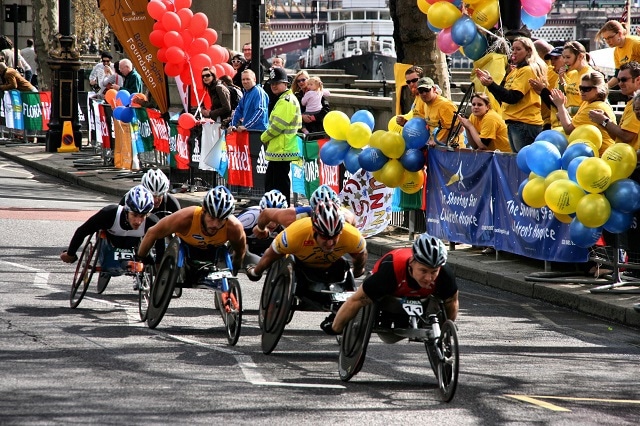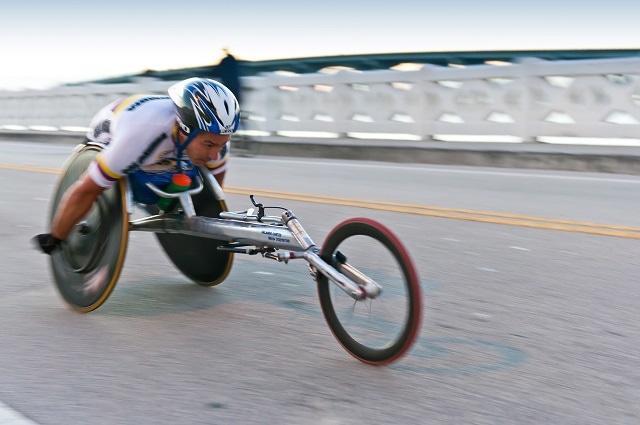
Image Credits: Tupungato/shutterstock.com
When wheelchair racing was first introduced a sport in the late 1940s, the wheelchairs used were very similar to everyday wheelchairs. Over the years, advanced engineering has been applied to the design and creation of more ergonomic and aerodynamic racing wheelchairs.
Factors to be Considered When Designing a Racing Wheelchair
The weight of the user and the wheelchair have a significant impact on the speed and acceleration of the wheelchair. Within the frame, designers try to find the optimum balance between the strength of the design and the weight of the design.
Similar considerations are put into the materials used in the wheelchair. In general, racing wheelchair designers make use of composite materials, with carbon fibre is being one of the best materials to use. Carbon fibre has a high stiffness with a low density, which allows it to increase the speed of the racing wheelchair.
Carbon fibre wheelchairs are more expensive than many other alternatives and the fibres must be designed into a matrix to attain the desired strength and stiffness. This matrix adds more difficulty and complexity to the design.
The physical dimensions of any racing wheelchair are incredibly dependent on the user’s physical ability and their physical dimensions. This means that most racing wheelchairs must be custom made for each user.
For example, the size of the rear wheels is dependent on the strength of the user. A larger wheel is more difficult to propel and thus requires a user with longer reach and greater strength; while a smaller wheel requires less strength and can be used by someone with a shorter reach.
Larger wheels are able to achieve higher top speeds than the smaller wheels. Smaller wheels sometimes allow racers to 'draft' or 'slipstream' where they follow behind another racer in order to reduce their own drag.
Seat position is one of the most important parameters considered by designers as it has one of the biggest effects on aerodynamics. Most seat designs use a nylon strap or cloth sling to position the racer in an ergonomically and aerodynamically effective position.
A common position is a knees up position which gives the racer driving force and torso support. It is important the designer not provide too much support such that it limits the movement of the racer when they are trying to propel their wheelchair.

Image Credits: Daniel Korzeniewski/shutterstock.com
Using Finite Element Analysis to Improve Design
Finite Element Analysis uses a computer to calculate how a racing wheelchair will be affected by the design choices above and how a number of physical constraints will affect the design.
The way these factors affect the racing wheelchair is largely dependent on the material as the analysis takes mechanical vibration, mechanical stress, weight, and strength into consideration.
This sort of analysis allows designers using expensive carbon fibres to test their designs in a simulation without wasting materials and money on prototypes.
Ultra Long Distance Racing Wheelchair Concept by Andrew Mitchell
Andrew Mitchell’s ultra-long distance racing wheelchair concept would use a number of materials working in unity to maximize the efficiency of the wheelchair. The wheelchair would use a carbon fibre shell and a foam core as the chassis.
The carbon’s strength to weight ratio and the shape providing foam core would make the chassis incredibly light and strong. Mitchell also incorporated aluminium, which is a lightweight material with a good strength to weight ratio although not as good a ratio as carbon fibres, into his design for extra load spreading.
In this design ergonomic comfort for the rider is also a major consideration. The rider is supported and positioned in such a way that the chest is open to provide better breathing on long rides.
It is also designed so that the racer’s shoulders are directly above the forward edge of the wheel which serves to maximize the power of the rider. These ergonomic considerations are incredibly important when designing an ultra long distance racing wheelchair concept.
Andrew Mitchell also believes that his design provides a psychological advantage for the racer as well as a physical advantage. His wheelchair features an inverted teardrop shape that extends the wheelbase which increases stability and also appears aggressive.
The psychological performance gain of racers that have equipment that looks to be better is what Mitchell aims to achieve. He does this by using colours to draw attention to the more important design components.
Yachiyo Honda Sun Racing Wheelchairs
Yachiyo Honda Sun’s Kiwami model was created as part of a collaborative effort from three companies within the Honda group.
It is their flagship model and uses carbon reinforced plastic. This composite material with an optimal layer design lead them to create ultra-lightweight carbon wheels, as well as a carbon frame which dampens vibration.
The Kiwami model is also custom tailored to each rider’s 3D measurements in order to maximize the beneficial aerodynamics and ergonomics of the wheelchair.
The Draft Mistral Racing Chair
Draft Racing Wheelchairs’ designs use a lightweight aluminium frame rather than the carbon fibre frames which other companies have turned to. This is done to increase the durability and rigidity of the structure.
The design of the frames tend to fall into three categories: V, open V or T styles depending on the body of the athlete for whom it is being built. Many of their wheelchairs have stainless steel spokes for their stiffness but Draft Racing also offers carbon fibre disks and bracing that weigh less and can ultimately increase the speed.
One of their top products is the Mistral. It is a custom built chair which avoids being heavy without sacrificing strength, performance or safety. One of the advantages of the mistral is that the seating position is customizable to help each rider achieve their highest efficiency position.
It is hard to predict the future of wheelchair racing but one can be sure that carbon fibre racing wheelchairs have changed the sport forever and will be in use for years to come.
Sources and Further Reading
Disclaimer: The views expressed here are those of the author expressed in their private capacity and do not necessarily represent the views of AZoM.com Limited T/A AZoNetwork the owner and operator of this website. This disclaimer forms part of the Terms and conditions of use of this website.